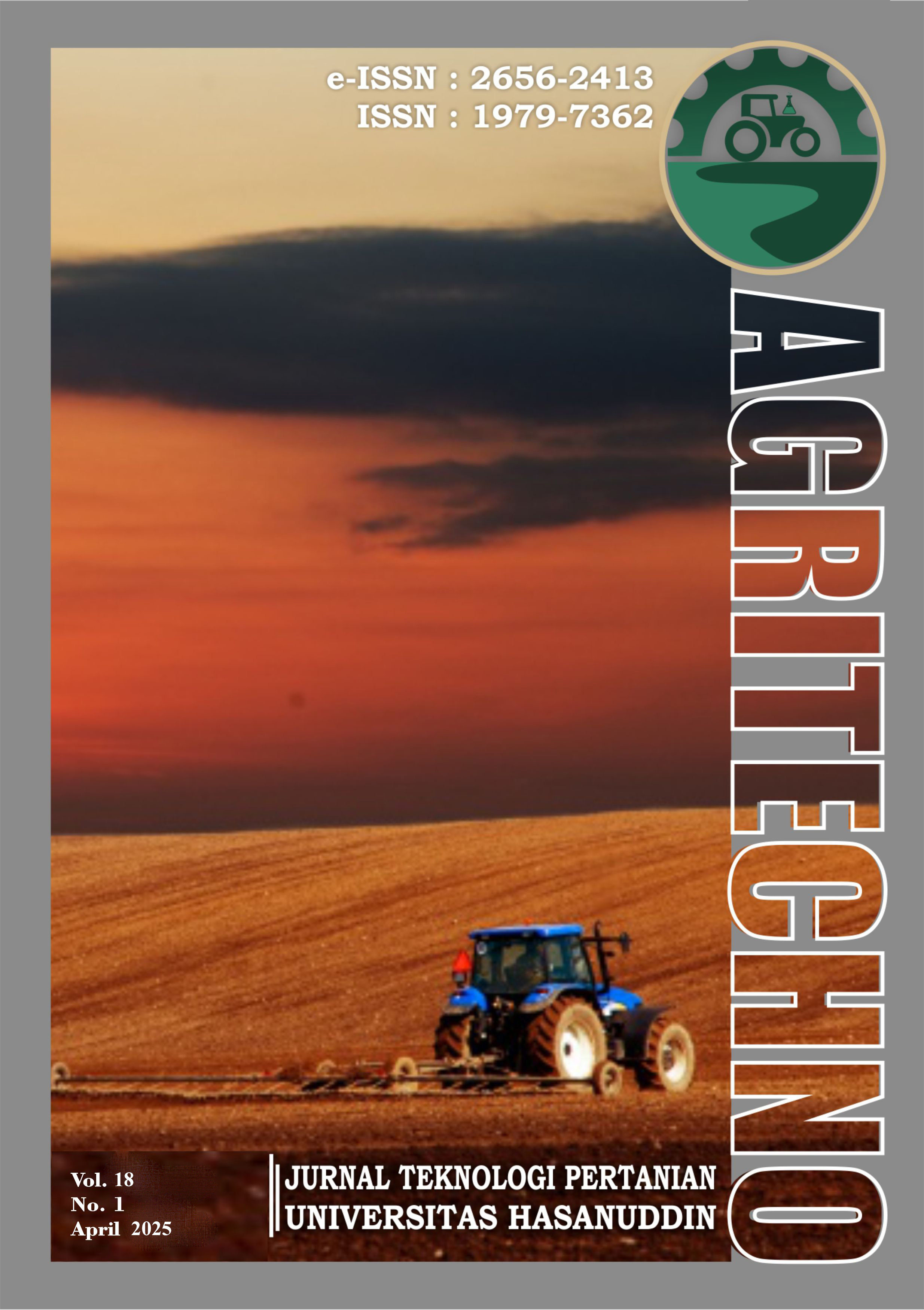ANALISIS KUALITAS FISIK BRIKET BIOARANG DARI LIMBAH THE DENGAN PEREKAT ORGANIK
##plugins.themes.academic_pro.article.main##
Abstract
Tea plants produce waste consisting of stems, leaves, and tea dregs. Tea stems are waste from the pruning process, tea leaves do not meet processing standards, and tea dregs are produced after brewing beverages. Tea plant waste, which is biomass, can be used as an alternative energy source in the form of biochar briquettes for cooking fuel. High-quality briquettes are defined according to SNI standard number 01-6235-200 with the following criteria: moisture content of less than 8%, ash content of less than 6%, and a calorific value of 500 cal/gram. Good biochar briquettes are characterized by ease of ignition during burning and stable combustion at a temperature of 350°C for a long time. The production process includes cleaning, drying, carbonization, sieving, preparing adhesive, mixing charcoal with adhesive, molding, and producing biochar briquettes. Testing is conducted to evaluate ease of ignition (s), burning duration (s), moisture content (%), ash content (%), and calorific value (cal/gram). Data analysis is carried out using a single-factor Analysis of Variance (ANOVA) method with Microsoft Excel and SPSS 27, based on a Completely Randomized Design (CRD) with 35 total samples. According to laboratory results, there were no significant differences in quality indicators such as ease of ignition (s), burning duration (s), moisture content (%), ash content (%), and calorific value (cal/gram), as the F critical value exceeded the actual F value, and the P-value was greater than 0.05. Biochar briquettes made from tea stems, leaves, and dregs meet the criteria based on ANOVA test results, with no significant differences found. Nevertheless, all data indicate that the biochar briquettes produced are of high quality in accordance with the SNI standard, making them suitable for use on a household scale.
##plugins.themes.academic_pro.article.details##
References
- Ariwidyanata, R., Wibisono, Y., Ary, D., Ahmad, M., Keteknikan, J., Teknologi, P.-F., Brawijaya, P.-U., Veteran, J., & Korespondensi, P. (2019). Karakteristik Fisik Briket dari Campuran Serbuk Teh dan Serbuk Kayu Trembesi (Samanea Saman) dengan Perekat Tepung Tapioka. Jurnal Keteknikan Pertanian Tropis Dan Biosistem, 7(3), 245–252.
- Efiyanti, L., Darmawan, S., Saputra, N. A., Wibisono, H. S., Hendra, D., & Pari, G. (2022). Quality Evaluation Of Coconut Shell Activated Carbon And Its Application As Precursor For Citronellal-Scented Aromatic Briquette. Rasayan Journal of Chemistry, 15(3), 1608–1618. https://doi.org/10.31788/RJC.2022.1536799
- Halim Daulay, A., Masthura, & Puspita Sari, H. (2022). Uji Fisis Briket Bioarang Berbahan Batang Teh (Camellia Sinensis). JISTech (Journal of Islamic Science and Technology) JISTech, 7(1), 24–31. http://jurnal.uinsu.ac.id/index.php/jistech
- Harahap, L. A., Daulay, S. B., & Munir, A. P. (2023). Tea waste briquette molder as an effort to reuse organic waste. IOP Conference Series: Earth and Environmental Science, 1241(1). https://doi.org/10.1088/1755-1315/1241/1/012061
- Indrawijaya, B., Mursida, L., & Dwi Andini, N. (2019). Fuel Briquettes from Waste Tea With Adhesive Kanji Glue. Jurnal Ilmiah Teknik Kimia UNPAM, 3(1), 23–28.
- Mansyur, S., & Apriani, E. (2023). Analysis of the effect of temperature and raw material mixes on the pyrolysis process with single retort-rocket stove technology on the characteristics of sawdust charcoal briquettes. International Journal of Industrial Optimization, 38–46. https://doi.org/10.12928/ijio.v4i1.6688
- Manyuchi, M., Mbohwa, C., Manyuchi, M. M., Mbohwa, C., & Muzenda, E. (2018). Potential to Produce Biomass Briquettes from Tea Waste. Proceedings of the International Conference on Industrial Engineering and Operations Management Washington DC, USA, 129–132. https://www.researchgate.net/publication/328275235
- Nugroho, B., Hamzah, F., Efendi, R., & Pramana, A. (2021). Characteristics of Charcoal Briquwttes from Palm Oil Midrib and Coconut Midrib with Tapioka Glue. International Journal of Advance Tropical Food, 3(1), 44–56. https://doi.org/10.26877/ijatf.v3i1.9302
- Nurhamida, Rusdianasari, & Zamhari, M. (2023). Pembuatan Briket Komposit Cangkang Sawit Dan Tempurung Kelapa Dengan Variasi Perekat Tepung Tapioka Sebagai Bahan Bakar Alternatif. Jurnal Teknologi, 23(2), 106–112.
- Nurramadani, A. H., Lestari, A., & Kurniawan, A. (2023). Flame Comparison Between Biopellets and Biobriquettes From Tea Dregs With A Mixture Of Corncob Waste. Journal of Agricultural and Biosystem Engineering in Tropic, 2(1), 42–50. https://jurnal.unupurwokerto.ac.id/index.php/j-abet/
- Prihatin, J. Y., Pratama, G. W., Kustanto, H., Pambudi, S., & Widodo, L. (2023). The Study Calorific Value of Organic Briquettes for Optimizing Healthy Food Drying as an Alternative to Rainy Weather. Atlantis Press, 1, 149–158. https://doi.org/10.2991/978-94-6463-284-2_18
- Santoso, H. (2022). Study of Making Biomass Briquettes from Coconut Shell and Tapioca Adhesive. BEST: Journal of Applied Electrical & Science Technology, 4(2), 71–74.
- Saptadi, N. T. S., Suyuti, A., Ilham, A. A., & Nurtanio, I. (2023). Composition Model of Organic Waste Raw Materials Image-Based to Obtain Charcoal Briquette Energy Potential. INTERNATIONAL JOURNAL ON INFORMATICS VISUALIZATION, 7(3), 899–909. https://www.esdm.go.id/
- Shafiyya, J. V. A., Kusumasari, H. S., Praharsiwi, I. M., & Mujiburohman, M. (2022). Pengaruh Kondisi Operasi dan Jenis Perekat Terhadap Karakteristik Briket Ampas Teh. Jurnal Energi Baru Dan Terbarukan, 3(3), 249–258. https://doi.org/10.14710/jebt.2022.14930
- Tunklová, B., Jeníček, L., Malaťák, J., Neškudla, M., Velebil, J., & Hnilička, F. (2022). Properties of Biochar Derived from Tea Waste as an Alternative Fuel and Its Effect on Phytotoxicity of Seed Germination for Soil Applications. Materials, 15(24). https://doi.org/10.3390/ma15248709





